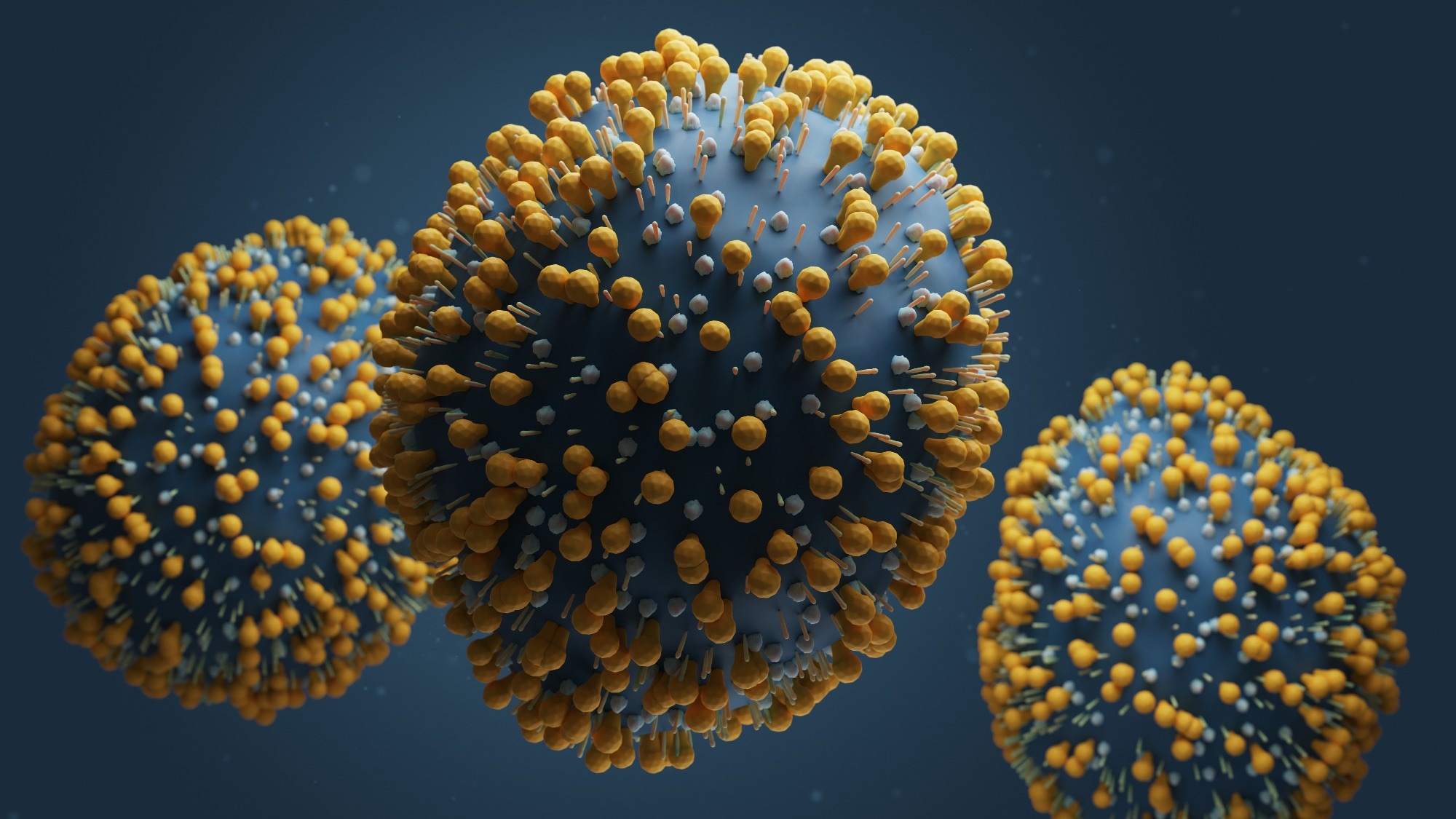In a study published in the journal Nature Communications, researchers screened ReFRAME (short for repurposing, focused rescue, and accelerated Medchem), a drug-repurposing library, for drugs against respiratory syncytial virus (RSV). They identified lonafarnib as a potent inhibitor of RSV fusion protein and investigated its therapeutic potential against an RSV infection.
Study: Drug repurposing screen identifies lonafarnib as respiratory syncytial virus fusion protein inhibitor. Image Credit: joshimerbin / Shutterstock
Background
RSV causes severe lower respiratory tract infections in young children, immunosuppressed individuals, and older adults, with millions of annual hospital admissions and deaths. The recent coronavirus disease 2019 (COVID-19) pandemic and associated interventions have led to altered RSV epidemiology, with a transient suppression and resurgence of RSV circulation, raising concerns about increased infections.
RSV infection treatment is currently symptomatic. While ribavirin shows in vitro efficacy, it is not very efficacious in patients. Palivizumab provides prophylaxis but is costly, offers only a partial reduction in hospitalization rates, and faces challenges like rapid resistance development. Although nirsevimab was recently approved for RSV prevention in newborns, there remains a dearth of therapeutic options.
Various antiviral strategies against RSV, including immunoglobulins, are being developed. Repurposing libraries containing licensed drugs or compounds in clinical development serve as repositories with potential for accelerated therapeutic applications. Researchers in the present study screened the ReFRAME library and identified lonafarnib as an RSV fusion protein inhibitor while demonstrating its therapeutic ability.
About the study
The library (of 12,000 molecules) was screened using a recombinant RSV subtype A strain GFP (short for green fluorescent protein) reporter virus. Cell viability was determined using an MTT (short for 3-[4,5-dimethylthiazol-2-yl]-2,5 diphenyl tetrazolium bromide) assay. The primary hit criteria were RSV infection ≤ 16% and cell viability ≥ 80%. Fourteen molecules met the primary criteria, and 16 additional molecules were selected. Two farnesyl-S-transferase inhibitors, lonafarnib, and tipifarnib, were evaluated and compared for their inhibitory effects on RSV infection. To identify the potential viral target of lonafarnib, passages of the RSV reporter virus were conducted with increasing doses of lonafarnib. The resulting virus populations were sequenced, and mutations were analyzed. The study additionally involved orthogonal infection assays, plaque reduction assays, RSV lentiviral pseudotype assays, and RSV F protein cell-to-cell membrane fusion assays. Surface plasmon resonance and crystallization experiments were conducted to investigate the interaction of lonafarnib with a recombinant RSV subtype A pre-fusion F protein.
Therapeutic effects of lonafarnib were evaluated by inoculating A549 cells with HRSV-A-GFP, treating with lonafarnib or ribavirin 24 hours post-inoculation, and monitoring virus spread over time. The drug’s effect in a more natural model of RSV infection and cell entry was investigated using the immortalized human basal cell line BCi-NS1.1, which was further differentiated into the pseudostratified ciliated epithelium.
Six mice were treated with oral lonafarnib or solvent control and infected with an RSV reporter virus. The animals’ weight was monitored, and on day 4, tissues were extracted, and lung RSV copy number was measured.
![A Screening and validation procedure. B HEp-2 cells were infected with rHRSV-A-GFP in presence of 5 µM compound. 48 hours later, infection and cell viability were quantified via GFP and MTT readouts. Dotted lines indicate primary hit criteria and dots represent means of two technical replicates. C HEp-2 cells were infected with HRSV-A-Luc at MOI 0.01 and treated with the indicated compound concentrations. 24 hours later, supernatant was transferred onto new cells for a second round of infection. Luminescence was quantified 24 hours post inoculation of both infection rounds. Cell viability was measured via MTT readout in treated, but uninfected cells. Mean ± SD of three independent experiments. Known RSV inhibitors (F protein: presatovir; N protein: RSV604, IMPDH inhibitors (AVN944, mycophenolic acid), HSP90 inhibitors (radiciol, HSP990). 4-Sulfocalix[6]arene Hydrate (4SC6AH, unknown target). Source data are provided as a Source Data file.](https://menshealthfits.com/wp-content/uploads/2024/02/ImageForNews_771592_17076972756075995.jpg) A Screening and validation procedure. B HEp-2 cells were infected with rHRSV-A-GFP in presence of 5 µM compound. 48 hours later, infection and cell viability were quantified via GFP and MTT readouts. Dotted lines indicate primary hit criteria and dots represent means of two technical replicates. C HEp-2 cells were infected with HRSV-A-Luc at MOI 0.01 and treated with the indicated compound concentrations. 24 hours later, supernatant was transferred onto new cells for a second round of infection. Luminescence was quantified 24 hours post inoculation of both infection rounds. Cell viability was measured via MTT readout in treated, but uninfected cells. Mean ± SD of three independent experiments. Known RSV inhibitors (F protein: presatovir; N protein: RSV604, IMPDH inhibitors (AVN944, mycophenolic acid), HSP90 inhibitors (radiciol, HSP990). 4-Sulfocalix[6]arene Hydrate (4SC6AH, unknown target). Source data are provided as a Source Data file.
A Screening and validation procedure. B HEp-2 cells were infected with rHRSV-A-GFP in presence of 5 µM compound. 48 hours later, infection and cell viability were quantified via GFP and MTT readouts. Dotted lines indicate primary hit criteria and dots represent means of two technical replicates. C HEp-2 cells were infected with HRSV-A-Luc at MOI 0.01 and treated with the indicated compound concentrations. 24 hours later, supernatant was transferred onto new cells for a second round of infection. Luminescence was quantified 24 hours post inoculation of both infection rounds. Cell viability was measured via MTT readout in treated, but uninfected cells. Mean ± SD of three independent experiments. Known RSV inhibitors (F protein: presatovir; N protein: RSV604, IMPDH inhibitors (AVN944, mycophenolic acid), HSP90 inhibitors (radiciol, HSP990). 4-Sulfocalix[6]arene Hydrate (4SC6AH, unknown target). Source data are provided as a Source Data file.
Results and discussion
Twenty-one molecules, including lonafarnib, demonstrated antiviral activity against RSV. Lonafarnib is approved for Hutchinson-Gilford progeria syndrome and is in phase III clinical trials for hepatitis delta virus infections. Lonafarnib, but not tipifarnib, demonstrated inhibition of RSV infection, as evidenced by reduced reporter virus activity, plaque reduction, and suppressed syncytia formation in infected cells. Further, lonafarnib, not tipifarnib, was found to interact with the pre-fusion F protein in a binding site that has been previously observed for other fusion inhibitors.
Lonafarnib-exposed virus populations accumulated two coding mutations (T335I and T400A) within the RSV fusion protein, leading to phenotypic resistance to lonafarnib. Further, lonafarnib was found to inhibit RSV’s entry into the cells by binding to the fusion protein and inhibiting membrane fusion. This inhibition was found to be overcome by resistance mutations in the fusion protein.
In vitro, combinations of lonafarnib and ribavirin showed minor inhibitory or slightly synergistic activity at selected doses. Lonafarnib treatment post-inoculation in A549 cells restricted the spread of the HRSV GFP virus by 30% as compared to controls. In the BCi-NS1.1 cell culture model, prophylactic lonafarnib treatment from both the apical and basolateral sides dose-dependently inhibited RSV infection, resulting in a 10- to 15-fold reduction in virus load. Therapeutic application of lonafarnib only from the basolateral side also reduced virus load by approximately 50% in a clinical RSV isolate infection.
In vivo, lonafarnib-treated animals showed a significantly reduced reporter virus signal in the lung and nose compared to controls. On day 4, a dose-dependent decline was observed in viral ribonucleic acid in the lungs of treated mice, and there was a lesser weight loss compared to controls. However, cellular infiltrates were observed in the lungs of lonafarnib-treated mice.
Conclusion
In conclusion, the study identified lonafarnib as a potential therapeutic candidate for RSV treatment, highlighting the utility of drug-repurposing studies. The findings demonstrate the promising antiviral activity of lonafarnib in cell culture as well as mice models of RSV infection. Further research is warranted to confirm the findings.








